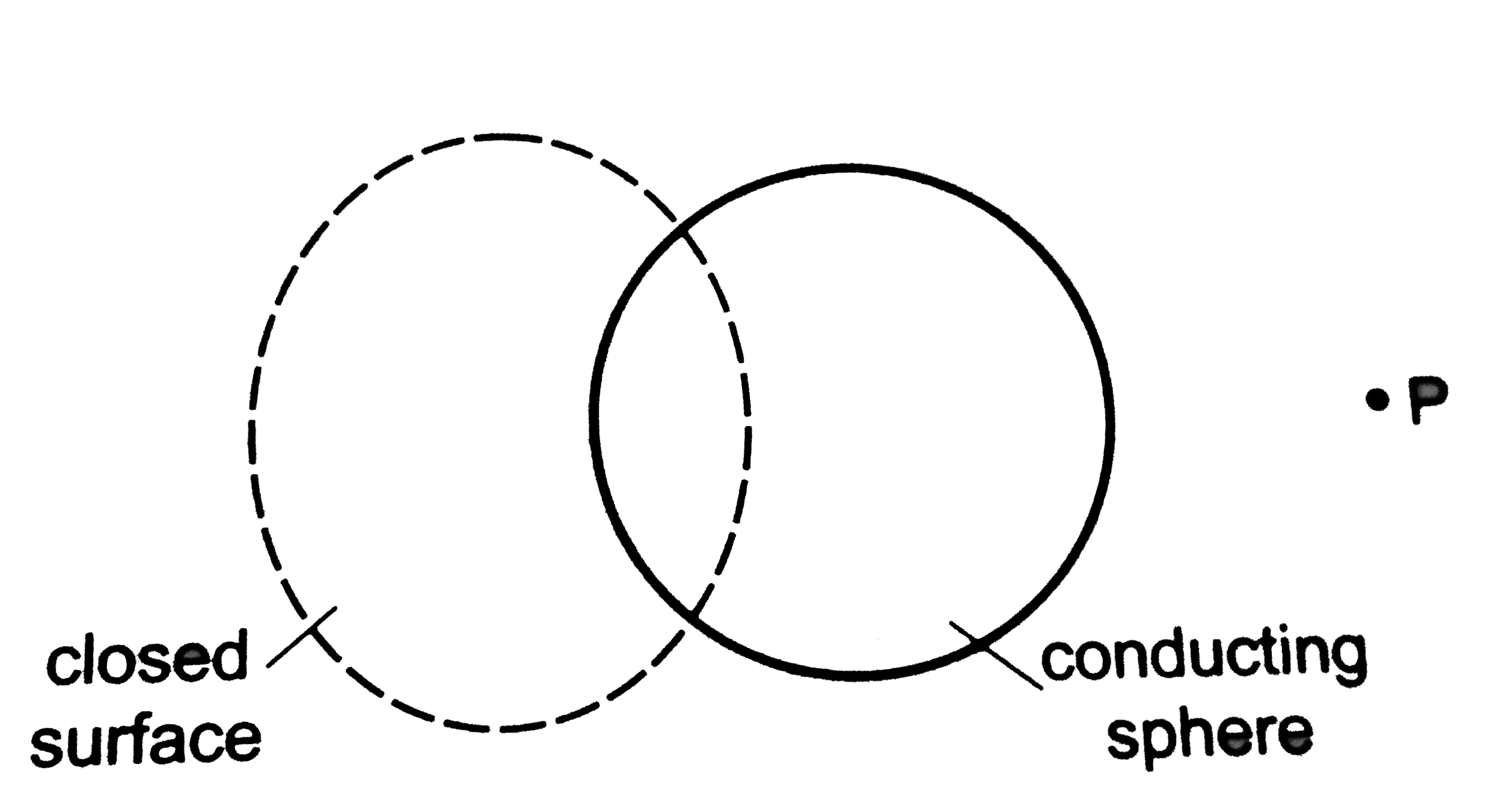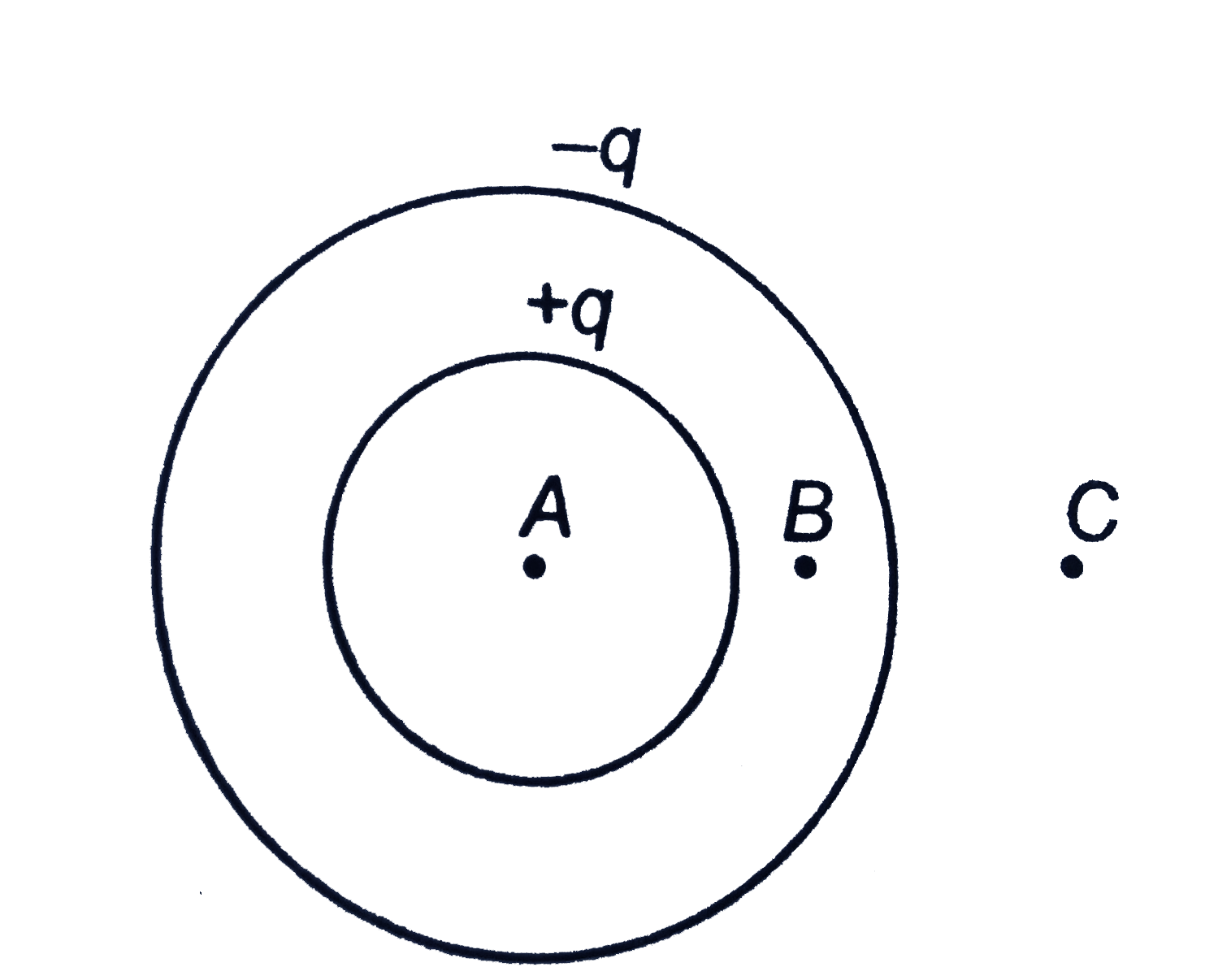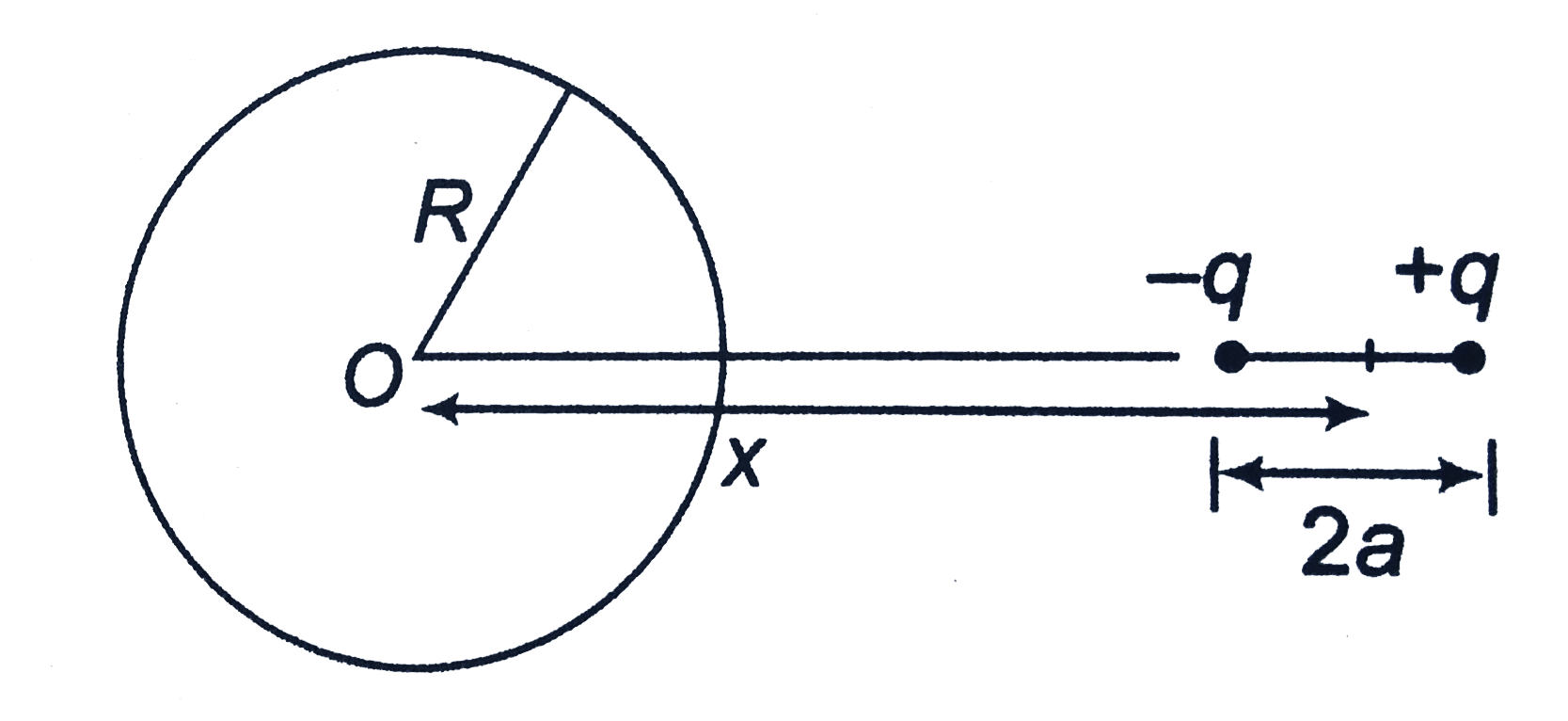Level 1 Objective from DC PANDEY ENGLISH ELECTROSTATICS for Class 12
| Class 12 | PHYSICS |
| Chapter | ELECTROSTATICS |
| DC PANDEY ENGLISH | Level 1 Objective |
| Medium | English |
| Academic Year | 2023-2024 |
Question 10
A metal sphere is suspended from a nylon thread. Initially, the metal sphere is uncharged. When a positively charged glass rod is brought close to the metal sphere, the sphere is drawn towards the rod. But if the sphere touches the rod, it suddenly flies away from the rod. Explain, why the sphere is first attracted then repelled? View SolutionQuestion 23
A point charge q1 is held stationary at the origin. A second charge q2 is placed at a point a, and the electric potential energy of the pair of charges is −6.4×10−8J. When the second charge is moved to point b, the electric force on the charge does 4.2×10−8J of work. What is the electric potential energy of the pair of charges when the second charge is at point b? View SolutionQuestion 33
In figure (a), a charge q is placed just outside the centre of a closed hemisphere. In figure (b), the same charge q is placed just inside the centre of the closed hemisphere and in figure (c), the charge is placed at the centre of hemisphere open from the base. Find the electric flux passing through the hemisphere in all the three cases.
 View Solution
View SolutionQuestion 40
Assertion: Electric potential on the surface of a charged sphere of radius R is V. Then electric field at distance r=R2 from centre is V2R. Charge is distributed uniformly over the volume.
Reason: From centre to surface, electric field varies linearly with r. Here r is distance from centre.View SolutionQuestion 44
Assertion: A small electric dipole is moved translatonally from higher potential to lower potential in uniform electric field. Work done by electric is positive.
Reason: When a positive charge is moved from higher potential to lower potential, work done by electric field positive.View SolutionQuestion 90
Two identical conducting spheres, fixed in space, attract each other with an electrostatic force of 0.108N when separated by 50.0cm, centre-to-centre. A thin conducting wire then connects the spheres. When the wire is removed, the spheres repel each other with an electrostatic force of 0.0360N. What were the initial charges on the spheres? View SolutionQuestion 103
A clock face has charges −q,−2q,,.....−12q fixed at the position of the corresponding numerals on the dial. The clock hands do not disturb the net field due to point charges. At what time does the hour hand point in the direction of the electric field at the centre of the dial.View SolutionQuestion 104
A charged particle of mass m=1 kg and charge q=2μC is thrown from a horizontal ground at an angle θ=45∘ with the speed 25m/s. In space, a horizontal electric field E=2×107 V/m exists in the direction of motion. Find the range on horizontal ground of the projectile thrown. Take g=10m/s2.View SolutionQuestion 105
Protons are projected with an initial speed vi=9.55×103m/s into a region where a uniform electric field E=(−720ˆj) N/C is present, as shown in figure. The protons are to hit a target that lies at a horizontal distance of 1.27 mm from the point where the protons are launched. Find
(a) the two projection angles 0 that result in a hit and
(b) the total time of flight for each trajectory.
 View Solution
View SolutionQuestion 106
At some instant the velocity components of an electron moving between two charged parallel plates are vx=1.5×105m/s and vy=3.0×106m/s.Suppose that the electric field between the plates is given by E=(120N/C)ˆj
. (a) What is the acceleration of the electron?
(b) What will be the velocity of the electron after its x-coordinate has changed by 2.0 cm? View SolutionQuestion 109
A uniform electric field of magnitude 250V/m is directed in the positive x-direction. A+12μC charge moves from the origin to the point (x,y)=(20.0cm,5.0cm).
(a) What was the change in the potential energy of this charge?
(b) Through what potential difference did the charge move?View SolutionQuestion 110
A small particle has charge −5.00μC and mass 2.00×10−4 kg. It moves from point A where the electric potential is VA=+200V. to point B, where the electric potential is VB=+800V. The electric force is the only force acting on the particle. The particle has speed 5.00ms at point A. What is its speed at point B? is it moving faster or slower at B than at A. Explain, View SolutionQuestion 111
A plastic rod has been formed into a circle of radius R. It has a positive charge +Q uniformly distributed along one-quarter of its circumference and a negative charge of −6Q uniformly distributed along the rest of the circumference (figure). With V = 0 at infinity, what is the electric potential −6Q
(a) at the centre C of the circle and
(b) at point P, which is on the central axis of the circle at distance z from the centre?
 View Solution
View SolutionQuestion 113
A point charge q1=4.00nC is placed at the origin, and a second point charge q2=−3.00nC, placed on the x-axis at x = + 20.0 cm. A third point charge q3=2.00nC is placed on the X-axis between q1,andq2. (Take as zero the potential energy of the three charges when they are infinitely far apart).
(a) What is the potential energy of the system of the three charges if q3 is placed at x= + 10.0 cm?
(b) Where should q3 be placed to make the potential energy of the system equal to zero? View SolutionQuestion 114
Three point charges, which initially are infinitely far apart, are placed at the corners of an equilateral triangle with sides d. Two of the point charges are identical and have charge q.If zero net work is required to place the three charges at the corners of the triangles, what must the value of the third charge be? View SolutionQuestion 122
A closed surface encloses a net charge of −3.60μC. What is the net electric flux through the surface?
(b) The electric flux through a closed surface is found to be 780N−m2/C. What quantity of charge is enclosed by the surface?
(c) The closed surface in part (b) is a cube with sides of length 2.50 cm. From the information given in part (b), is it possible to tell where within the cube the charge is located? Explain.View SolutionQuestion 126
A cube has sides of length L. It is placed with one corner at the origin as shown in figure. The electric field is uniform and given by E=−Bˆi+Cˆj−Dˆk, where B, C and D are positive constants.

(a) Find the electric flux through each of the six cube faces S1,S2,S3,S4andS5andS6.
(b) Find the electric flux through the entire cube. View SolutionQuestion 132
Three concentric spherical metallic shells A, B and C of radii a, b and c (a < b < c) have surface charge densities σ, −σ and σ respectively.
(i) Find the potential of the three shells A, B and C.
(ii) If the shells A and C are at the same potential, obtain the relation between the radii a, b and c.View SolutionQuestion 133
A charge Q is placed at the centre of an uncharged, hollow metallic sphere of radius a. (a) Find the surface charge density on the inner surface and on the outer surface. (b) If a charge q is put on the sphere, what would be the surface charge densities on the inner and the outer surface? (c) Find the electric field inside the sphere at a distance x from the centre in the situations (a) and (b).View SolutionQuestion 137
A solid sphere of radius R has a charge +2Q. A hollow spherical concentric with the first sphere that has net charge -Q.

(a) Find the electric field between the spheres at a distance r from the centre of the inner sphere. [R<r<3R]
(b) Calculate the potential difference between the spheres.
(c) What would be the final distribution of charges, if a conducting wire joins the spheres?
(d) Instead of (c), if the inner sphere is earthed, what is the charge on it?View SolutionQuestion 138
Three concentric conducting spherical shells of radii R,2R and 3R carry charges Q,−2Q and 3Q, respectively.

a. Find the electric potential at r=R and r=3R where r is the radial distance from the centre . b. Compute the electric field at r=52R
c. Compute the total electrostatic energy stored in the system.
The inner shell is now connected to the external one by a conducting wire, passing through a very small hole in the middle shell.
d. Compute the charges on the spheres of radii R and 3R.
e. Compute the electric field at r=52RView SolutionQuestion 139
In the diagram shown the charge +Q is fixed. Another charge +2q and mass M is projected from a distance R from the fixed charge. Minimum separtion between the two charge if the velocity becomes 1√3 time of the projected velocity, at this moment is (Assume gravity to be absent)
 View Solution
View SolutionQuestion 141
Two point charges a and b whose magnitude are same, positioned at a certain distance along the positive x-axis from each other a is at origin. Graph is drawn between electrical field strength and distance x from a. E is taken positive if it is along the line joining from a to b From the graph it can be decided that
 View Solution
View SolutionQuestion 148
The curve represents the distribution of potential along the staight line joining the two charges Q1andQ2 (separated by a distance r) then which of the following statements are correct?

1. |Q1|>|Q2|
2. Q1 is positive in nature
3. A and B are equilibrium points
4. C is a point of unstabkle equilibriumView SolutionQuestion 156
A charge +Q is uniformly distributed in a spherical volume of radius R. A particle of charge +q and mass m projected with velocity v0 the surface of the sherical volume to its centre inside a smooth tunnel dug across the sphere. The minimum value of v0 such tht it just reaches the centre (assume that thee is no resistance on the particle except electrostatic force) of he sphericle volume isView SolutionQuestion 157
Two identical coaxial rings each of radius R are separated by a distance of √3R. They are uniformly charged with charges +Q and −Q respectively. The minimum kinetic energy with which a charged particle (charge +q) should be projected from the centre of the negatively charged ring along the axis of the rings such that it reaches the centre of the positively charged ring is View SolutionQuestion 167
Two identical charged spheres are suspended by strings of equal lengths. The strings make an angle of 30∘ with each other. When suspended in a liquid of density 0.8gcm−3, the angle remains the same. If density of the material of the sphere is 1.6gcm−3, the dielectric constant of the liquid isView SolutionQuestion 173
There are two uncharged identicasl metallic spheres 1 and 2 of radius r separated by a distance d(d>>r). A charged metalllic sphere of same radius having charge q is touched with one of the sphere. After some time it is moved away fom the system. Now, the uncharged sphere is earthed. Charge on earthed sphere is View SolutionQuestion 190
A sphere of charges of radius R carries a positive charge whose volume chasrge density depends only on the distance r from the ball's centre as ρ=ρ0(1−rR), where ρ0 is constant. Assume epsilon as theh permittivity of space.
The magnitude of electric field as a function of the distance r inside the sphere is given byView SolutionQuestion 191
A sphere of charges of radius R carries a positive charge whose volume charge density depends only on the distance r from the ball's centre as ρ=ρ0(1−rR), whereρ0 is constant. Assume epsilon as theh permittivity of space.
The magnitude of the electric field as a functiion of the distance r outside the balll is given byView SolutionQuestion 192
A sphere of charges of radius R carries a positive charge whose volume chasrge density depends only on the distance r from the ball's centre as ρ=ρ0(1−rR), where ρ0 is constant. Assume epsilon as theh permittivity of space.
The value of distance rm at which electric field intensity is maximum is given by View SolutionQuestion 194
A solid metallic sphere of radius a is surrounded by a conducting spherical shell of radius b(b>a). The solid sphere is given a charge Q. A student measures the potential at the surface of the solid sphere as V and the potential at the surface of spherical shell as Vb. After taking these readings, he decides . to put charge of −4Q on the shell. He then noted the readings of the potential of solid sphere and the shell and found that the potential difference is △V .
He then connected the outer spherical shell to the earth by a conducting wire and found that the charge on the outer surface of the shell as He then decides to remove the earthing connection from the shell and earthed the inner solid sphere. Connecting the inner sphere with the earth he observes the charge on the solid sphere as q2. He then wanted to check what happens if the two are connected by the conducting wire. So he removed the earthing connection and connected a conducting wire between the solid sphere and the spherical shelll. After the connections were made he found the charge on the outer shell as q3.
Potential difference (△CV) measured by the student between the inner solid shere and outer shell after putting a charge −4Q isView SolutionQuestion 195
A solid metallic sphere of radius a is surrounded by a conducting spherical shell of radius b(b>a). The solid sphere is given a charge Q. A student measures the potential at the surface of the solid sphere as V and the potential at the surface of spherical shell as Vb. After taking these readings, he decides . to put charge of −4Q on the shell. He then noted the readings of the potential of solid sphere and the shell and found that the potential difference is △V .
He then connected the outer spherical shell to the earth by a conducting wire and found that the charge on the outer surface of the shell as He then decides to remove the earthing connection from the shell and earthed the inner solid sphere. Connecting the inner sphere with the earth he observes the charge on the solid sphere as q2. He then wanted to check what happens if the two are connected by the conducting wire. So he removed the earthing connection and connected a conducting wire between the solid sphere and the spherical shelll. After the connections were made he found the charge on the outer shell as q3.
q2 is View SolutionQuestion 196
A solid metallic sphere of radius a is surrounded by a conducting spherical shell of radius b(b>a). The solid sphere is given a charge Q. A student measures the potential at the surface of the solid sphere as V and the potential at the surface of spherical shell as Vb. After taking these readings, he decides . to put charge of −4Q on the shell. He then noted the readings of the potential of solid sphere and the shell and found that the potential difference is △V .
He then connected the outer spherical shell to the earth by a conducting wire and found that the charge on the outer surface of the shell as He then decides to remove the earthing connection from the shell and earthed the inner solid sphere. Connecting the inner sphere with the earth he observes the charge on the solid sphere as q2. He then wanted to check what happens if the two are connected by the conducting wire. So he removed the earthing connection and connected a conducting wire between the solid sphere and the spherical shelll. After the connections were made he found the charge on the outer shell as q3.
q3 is View SolutionQuestion 197
A 4.00kg block carrying a charge Q=50.0μC is connected to a spring for which k = 100 N/ m. The block lies on a frictionless horizontal track, and the system is immersed in a uniform electric field of magnitude E=5.00×105Vm, directed as shown in figure. If the block is released from rest when the spring is unstretched (at x = 0).

(a) By what maximum amount does the spring expand?
(b) What is the equilibrium position of the block?
(c) Show that the block's motion is simple harmonic and determine its period.
(d) Repeat part (a) if the coefficient of kinetic friction between block and surface is 0.2. View SolutionQuestion 198
A particle of mass m and charge −Q is constrained to move along the axis of a ring of radius a. The ring carries a uniform charge density +λ along its length. Initially, the particle is in the centre of the ring where the force on it is zero. Show that the period of oscillation of the particle when it is displaced slightly from its equilibrium position is given by
T=2πsq√2ε0ma2λQView SolutionQuestion 200
A long non-conducting, massless rod of length L pivoted at its centre and balanced with a weight w at a distance x from the lefrt end. At the left and right ends fo the rod are attached small conducting sphers with positive charfges q and 2q respectively. A distance h directly beneath each of these spheres is a fixed sphere with positive charge Q.
(a) Find the distance x where the rod is horizontal and balanced.b. What valueshold h have so that the rod exerts no vertical force on the bearing when the rod is horizontal and balanced?View SolutionQuestion 201
The electric potential varies in space according to the relation V=3x+4y. A particle of mass 10 kg starts from rest from point (2,3.2) m under the influence of this field. Find the velocityr,f the particle when it crosses the x-axis. The charge on the particle is +1μC. Assume V (x, y)are in SI units. View SolutionQuestion 202
A simple pendulum with a bob of mass m=1 kg, charge q=5μC and string length imis given a horizontal velocity a in a uniform electric field E=2×106Vm at its bottommost point A, as shown in figure. It is given that the speed a is such that the particle leaves the circle at point C. Find the speed a (Take g=10ms2)
 View Solution
View SolutionQuestion 203
Eight point charges of magnitude Q are arranged to form the corners of a cube of side L. The arrangement is made in manner such that the nearest neighbour of any charge has the opposite sign. Initially, the charges are held at rest. If the system is let free to move, what happens to the arrangement? Does the cube-shape shrink or expand? Calculate the velocity ct each charge when the side-length of the cube formation changes from L to nL. Assume that the mass of each point charge is m. View SolutionQuestion 205
Two point like charges Q1 and Q2 are positioned at point 1 and 2. The firld intensity to the right of the chaege Q2 on the line that passes through the two charges varies accoreing to a law that is represented schematically in fig. The field intensity is assumed to be positive if its direction coincides with the positive direction on the x-axis. The distance between the charges is l.

The ratio of the absolute values of the charges |Q1/Q2| is View SolutionQuestion 206
A conducting sphere S1 of radius r is attached to an insulating handle. Another conduction sphere S2 of radius R is mounted on an insulating stand. S2 is initially uncharged. S1 is given a charge Q brought into contact with S2 and removed. S1 is recharge such that the charge on it is again Q and it is again brought into contact with S2 and removed. This procedure is repeated n times.
a. Find the electrostatic energy of S2 after n such contacts with S1.
b. What is the limiting value of this energy as n→∞ ?View SolutionQuestion 207
A proton of mass m and accelerated by a potential difference Vgets into a uniform electric field of a parallel plate capacitor parallel to plates of length 1 at mid-point of its separation between plates. The field strength in it varies with time as E = at, where a is a positive constant. Find the angle of deviation of the proton as it comes out of the capacitor. (Assume that it does not collide with any of the plates.) View SolutionQuestion 208
Two fixed, equal, positive charges, each of magnitude 5×10−5 coul are located at points A and B separated by a distance of 6m. An equal and opposite charge moves towards them along the line COD, the perpendicular bisector of the line AB.
The moving charge, when it reaches the point C at a distance of 4m from O, has a kinetic energy of 4 joules. Calculate the distance of the farthest point D which the negative charge will reach before returning towards C.
 View Solution
View SolutionQuestion 209
A positive charge Q is uniformly distributed throughout the volume of a dielectric sphere of radius R. A point mass having charge +q and mass m is fired toward the center of the sphere with velocity v from a point at distance r(r>R) from the center of the sphere. Find the minimum velocity v so that it can penetrate (R/2) distance of the sphere. Neglect any resistance other than electric interaction. Charge on the small mass remains constant throughout the motion.
 View Solution
View SolutionQuestion 210
Two concentric rings placed in a gravity free region in yz-plane one of radius R carries a+Q and second of radius 4R and charge –8Q distributed uniformly over it. Find the velocity with which a point charge of mass m and charge +q should be projected from a a distance 3R from the centre of rings on its axis so that it will reach to the centre of the rings.View SolutionQuestion 212
A point charge –q revolves around a fixed charge +Q in elliptical orbit. The minimum ar.d maximum distance of q from Q are r1 and r2, respectively. The mass of revolving particle is Q>q and assume no gravitational effects. Find the velocity of q at positions when it is at r1 and r2 distance from Q. View SolutionQuestion 213
Three concentric, thin, spherical, metallic shells have radii 1, 2, and 4 cm and they are held at potentials 10,0 and 40V respectively. Taking the origin at the common centre, calculate the following:
(a) Potential at r = 1.25 cm
(b) Potential at r = 2.5 cm
(c) Electric field at r =1.25 cmView SolutionQuestion 214
A thin insulating wire is stretched along the diameter of an insulated circular hoop of radius R. A small bead of mass m and charge –q is threaded onto the wire. Two small identical charge +Q are tied to the hoop at points opposite to each other, so that the diameter passing through them is perpendicular to the thread (see figure). The bead is released at a point which is a distance x_0, from the centre of the hoop. Assume that x0<R.

a. What is the resultant acting on the charged bead?
b. Describe (qualitatively) the motion of the bead after it is released.
c. Use the assumption that x/R<<1 to obtain an approximate equation of motion and find the displacement ad velocity of the bead as functions of time.
d. When will the velocity of the bead will become zero for the first time?View SolutionQuestion 215
The region between two concentric spheres of radii ‘a’ and ‘b’, respectively (see figure), has volume charge density p=Ar, where A is a constant and r is the distance from the centre. At the centre of the spheres is a point charge Q. The value of A such that the electric field in the region between the spheres will be constant, is :
 View Solution
View SolutionQuestion 216
A nonconducting ring of mass m and radius R, with charge per unit length λ is shown in fig. It is then placed on a rough nonconducting horizontal plane. At time t=0, a uniform electric field →E=E0ˆi is switched on and the ring starts rolling without sliding. Determine the friction force (magnitude and direction ) acting on the ring.
 View Solution
View SolutionQuestion 217
A rectangular tank of mass m0 and charge Q is placed over a smooth horizontal floor. A horizontal electric field E exist in the region. Rain drops are falling vertically in the tank at the constant rate of n drops per second. Mass of each drop is m. Find velocity of tank as function of time. View SolutionQuestion 218
In a region an electric field is setu!l with its strength E=15N/C and it makes an angle of 30° with the horizontal plane as shown in figure. A ball having a charge 2C, mass 3kg and coefficient of restitution with ground 0.5 is projected at an angle of 30° with the horizontal along the direction of electric field with speed 20 m/s. Find the horizontal distance travelled by ball from first hit with the ground to the second time when it hits the ground.
 View Solution
View Solution
All Exercises from DC PANDEY ENGLISH Class 12 PHYSICS ELECTROSTATICS
- ASSERTION AND REASON
- CHECK POINT 1.1
- CHECK POINT 1.2
- CHECK POINT 1.3
- CHECK POINT 1.4
- CHECK POINT 1.5
- EXERCISE 24.1
- EXERCISE 24.2
- EXERCISE 24.3
- EXERCISE 24.4
- EXERCISE 24.5
- EXERCISE 24.6
- EXERCISE 24.7
- LEVEL 1 ASSERTION AND REASON
- LEVEL 1 OBJECTIVE
- LEVEL 1 SUBJECTIVE
- LEVEL 2 SINGLE CORRECT
- MATCH THE COLUMNS
- MEDICAL ENTRANCES GALLERY
- SUBJECTIVE_TYPE
- TAKING IT TOGETHER
- EXAMPLE
- EXAMPLE TYPE 5
- EXAMPLE TYPE 6
- EXAMPLE TYPE 8



 Draw the graph of electric field strength.
Draw the graph of electric field strength. 











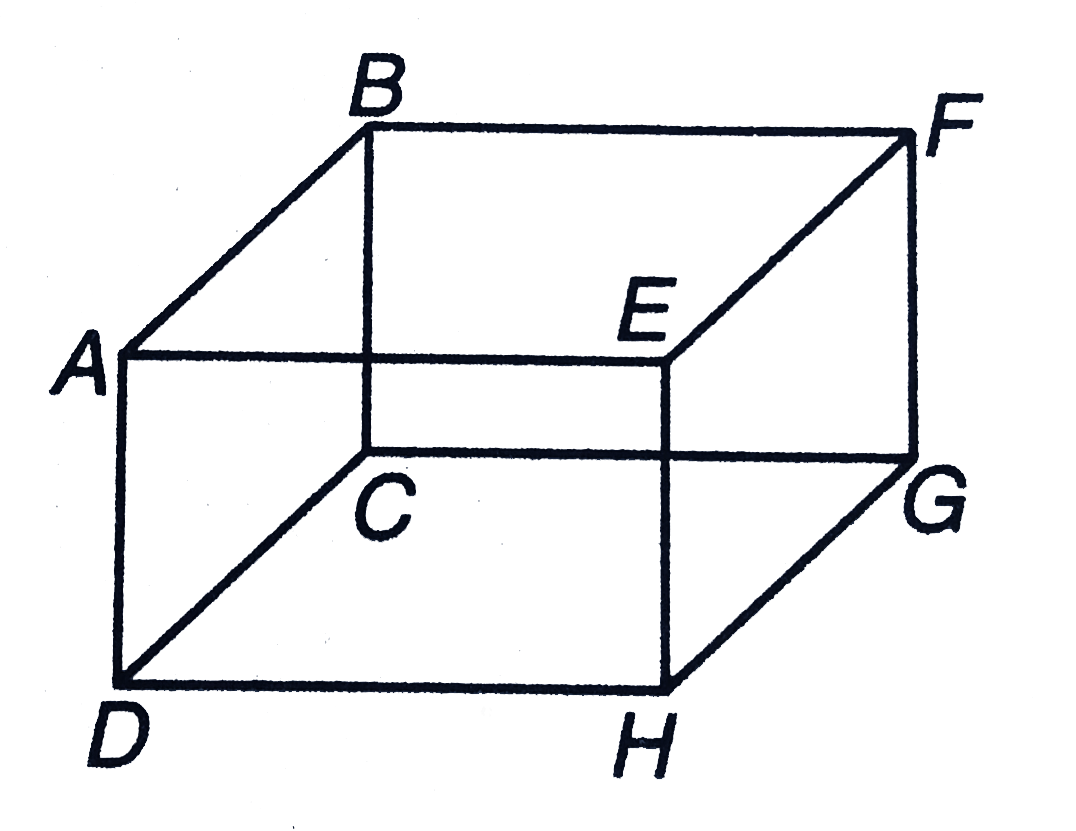



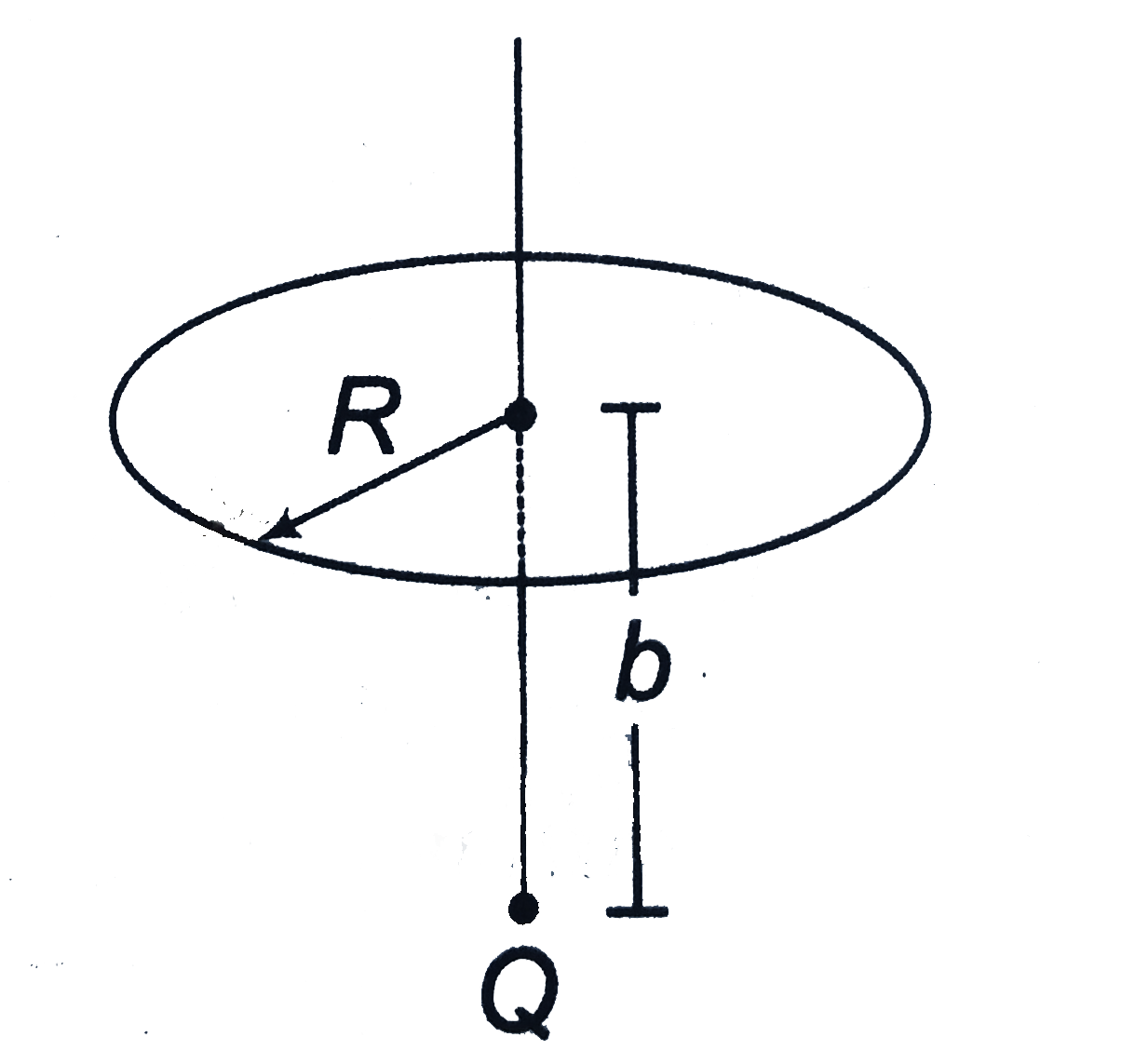







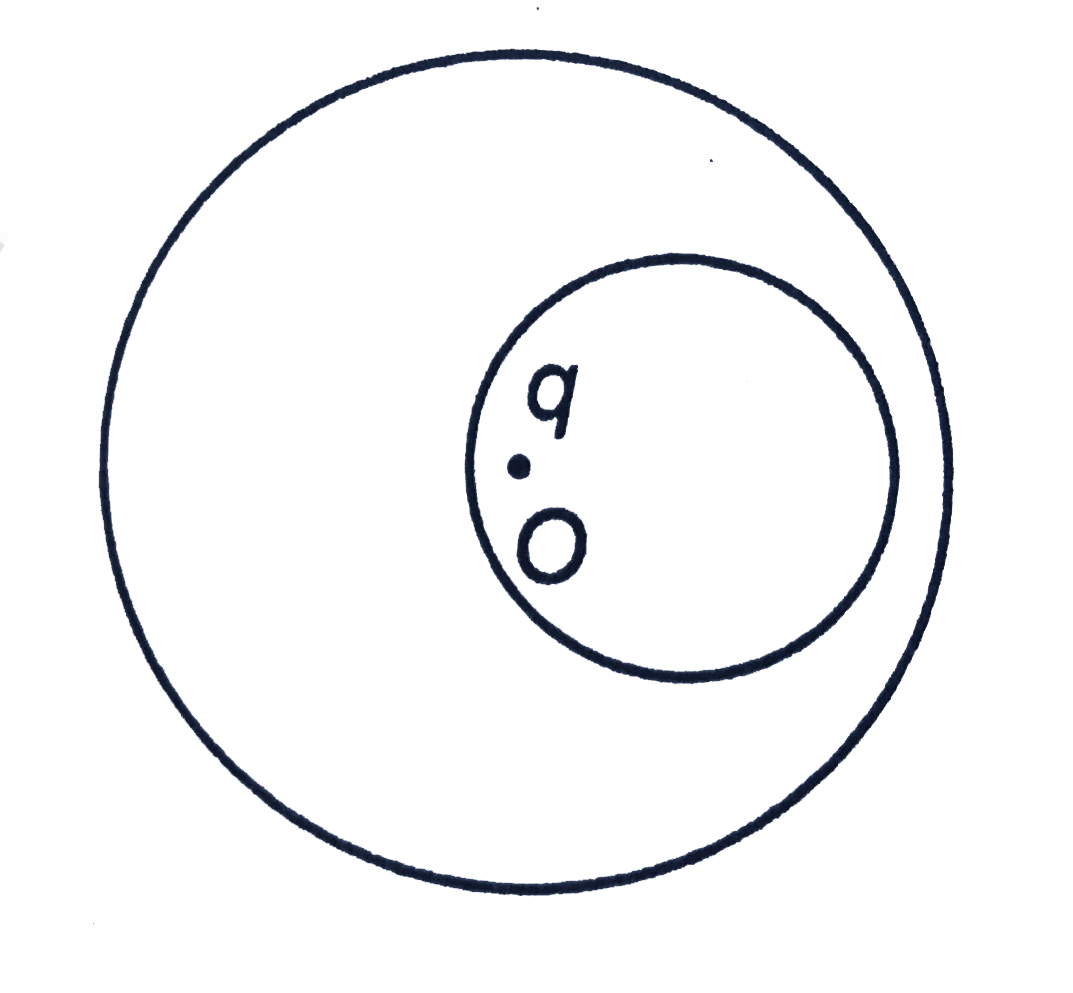




 where ,
where , 




